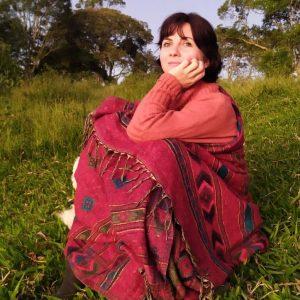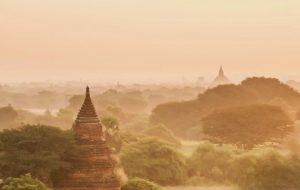
All my bones felt rusted and I had the sensation that my eyeballs might fall out of my head at any moment. Each breath felt as if I had to fight an elephant kneeling on my chest. This was the first entrance of the COVID-19 virus into my body. Hospitals were full and we had all heard that people were dying. If I was going to die, I thought, it would be in my own home on the mountain where I grew up.
It was my 40th birthday. My family had just come to the window, wearing masks and bearing a beautiful cake and a bright, flickering candle to sang happy birthday wearing while standing outside in the garden. I still carry that image in my mind. I wanted so badly to hug them, to dance and share that day with them—a day on which I had planned to celebrate a new phase in my life after a period of so much turmoil and while still in the midst of an ugly divorce. Instead, I sat down to eat my favorite cake that I could not taste, a common symptom of COVID-19. Alone and miserable, I wept, which made everything worse, and so I laughed as how tragic it all felt! Then I put the cake in the freezer and crawled back under the blankets.
That night I was unable to sleep, with pain creeping all over my body. At that moment, it felt like a good place and a good time to die. So I focused on acceptance and began making arrangements. I wrote down my bank details and passwords for the convenience of my family members. I drafted a letter explaining that, while I didn’t want to die, I had accepted my circumstances: I had lived an amazing life and was deeply grateful; I had traveled widely and met important teachers who gave me the tools to be alright in this moment. Basically I had attained all of my dreams, but there was one act that I was afraid I would need to be reborn in order to experience: the Mount Kailash pilgrimage in Tibet. I wrote all of this down and placed the letters in a pink-and-gold paper box in my living room. And then I lay in bed dreaming of Mount Kailash, as I had done for probably 20 years.

I can’t remember now how I first heard of Mount Kailash, but I knew of it even before moving to India in 2003. My mom and my grandmother told me stories of the sages and gods living there, and about how holy it was for Buddhists and Hindus. They planted a mystical image in my mind, although they themselves had never been there—sometimes our thoughts are stronger than reality (whatever “reality” means, but the things we believe are real). Besides, I’ve always liked the idea of pilgrimage—walking with a purpose-filled heart and spirit. I guess there is no better state of mind in which to be on this planet!
Two weeks passed, and I didn’t die. Nobody found the box of letters, and I reclaimed my frozen cake, eating it but now crying tears of joy—also a comic scene!
Of course, it wasn’t only Mount Kailash, but Tibet that was the place of my dreams. In 2000, aged 18, I had made a definite connection with Buddhism when I visited Mongolia. From there I moved to India and studied thangka painting and the Dharma for a few years, and have returned every year since. I have studied Tibetan art for 20 years, had a child with a Tibetan man, yet I had never been to Tibet. It just felt so out of reach.
Two years after my COVID incident, an unexpected opportunity to visit Mount Kailash appeared! My partner and I flew to Chengdu in China, ready to fly onward to Lhasa, but we were surprised to receive the news that the authorities had withdrawn our permits to enter the Tibet Autonomous Region (TAR). My mind felt frozen in silence trying to make sense of the senselessness of it all. Memories of my 40th birthday and canceled celebrations came flooding back. I had glanced beyond the threshold, begun packing to leave the Earth, and then the door closed and I returned to life. Now I saw myself packed and ready to see Mount Kailash; I catch a glimpse of it and then the door closes in my face.
Where should I go? Not back under the blankets this time, but out into the busy streets of Chengdu, to the offerings of tea in the beautiful environs of Wenshu Monastery. I sat inside one of the wooden tearooms, looking through the carved window panels at the bamboo trees that swayed gently in the breeze, my skin sticky with humidity, my lips salty as I slowly sipped the floral tea.
Beauty. Beauty always brings me back to the center of all paths when they begin to overlap inside my mind. Beauty is the ability to read the poetry of any situation. It has more to do with how we see than what we see. And I try to practice as often as I can: to laugh in the face of tragedy; to cry out of joy and to gaze into the mystery when life dances with light and shadow, presenting and hiding opportunities like stars behind layers of silk. If I can’t pass this door and walk the path that had been presented to me, couldn’t I still appreciate the dance? The lila, the divine play of the goddess?
I turned to my partner and confirmed with excitement: “Let’s go to Tibet!” After all, whenever a door closes, another opens—were we able to see the open door? We definitely did, and soon made arrangements to travel to the traditional region of Kham, the opposite side to where we had planned to visit but not part of the TAR, so we could travel there without a permit.
A passage from the Dzogchen text Spectrum of Ecstasy helped to make me aware that the outer journey is always about coming to know our inner landscapes. The emotions stirring in my heart gave color to all the landscapes I was about to enter. I wondered if that also meant that this would be a pilgrimage after all:
We could experience our lives as a series of juxtaposed extremes: pain and pleasure, agony and ecstasy, tragedy and comedy, boredom and obsession . . . but with either extremes—controlling our emotions or abandoning ourselves to intensity—what we are avoiding is direct and naked confrontation with the real nature of our energy. With either extreme we never actually experience ourselves.
As a thangka artist it would be crucial to visit the important temples and monasteries, the source of what has been the focus of my life for 20 years. Mount Kailash was the door, and the landscape I entered was eastern Tibet and its complex representations of Buddhist beliefs and practices, a life pilgrimage to understand the Buddhadharma, the universal Truth, through the sacred imagery that people have created to connect with what we call the Divine.

The inner temple
Finally, I entered the Tibet that I had dreamed of for so long. Of course, I was aware that I had a certain image in my mind and I was ready to encounter “reality.” I was very curious and kept my perceptions open wide. We started by driving from Chengdu, crossing a high pass under heavy rain before arriving in Lagan. It was only in the morning that the clouds opened to reveal the pastoral valleys with herds of yaks contrasted against the rocky gray mountains we had passed the day before. Despite being a very small town, Lagan has a large, important temple with a spacious patio, shining golden roofs and elaborate paintings. And that was only the first of our visits to so many other temples—many monasteries with more than a thousand monks seated in rows and reciting synchronized prayers with drums and bells.
Most temples had been renovated relatively recently, so it was rare that I had the feeling of touching my spiritual roots as I had expected to do by coming to the source of the essence of Vajrayana. I yearned to feel the essence of what had held together all these huge and monumental architectures. I felt overcome by the empowered richness and absolute presence that the monasteries had in a country that we were denied access to because of our connection to the religion. Many of the rinpoches from those monasteries had started to see a growing influx of Chinese followers and donors, and one of the practices was to demonstrate what they could do with so much funding: building richer temples than the previous rinpoches to draw more followers.
The original Shechen Monastery, where so many precious teachers had lived, was overshadowed by these shining new temples. I visited so many pompous temples with golden metal arabesques, incredible painted mandalas in the ceiling, intricate murals, huge statues that even as a thangka artist, I asked myself: “How much do we need?” I have also been asking the same question of myself with regard to my own art. At the same time, I recognize the power of imagery to unlock parts of the brain and allow access to deeper experiences.

The imagery that we see in thangkas is actually an artifice, a tool, a vehicle that bridges the gulf between the world of form and the invisible world of transcendence and liberation from delusions and attachment, enabling an expansion in absolute wisdom resting in the return to the basic ground of being—which is simple nature. Does it still make sense to need temples to sustain an enlightened being? Once one attains nirvana, there is no need for artifice. Can’t we see that these wonderful edifices can become actual obstacles on the path? It is possible to become attached to the tools, the deities, the yidams, the gurus, the drums, the mantras, and the robes, and to totally forget why we actually set out on this path.
Knowledge is power and power magnetizes all other things, including money and sex—we all know this, yet we believe that temples can be immune. I once thought that religious institutions had more tools to help them hold on to their principles and be less corrupted. But so many people take the vow of simplicity and celibacy and attract the very things they set out to renounce. This is even worse than those who openly live a “mundane” life, who contribute to hypocrisy by using any kind of status to attract power for their own benefit, which is a sure way to prevent any kind of real virtue from flourishing.
No matter what the practice or teaching, ego loves to wait in ambush to appropriate spirituality for its own survival and gain. ― Chögyam Trungpa, Cutting Through Spiritual Materialism
The appearance one chooses to “dress” oneself in is symbolic. If you have an important status in a society or an institution, you will attract these things and deal with power and sensual games. But someone with the same knowledge who “dresses” for a simple life will probably attract only some birds that will nest on his roof; silence and little attention. This person will actually experience peace, because they refuse to adopt exaggerated ornamentation.
And this I saw by visiting some serious yogis and monks living in the caves of Dzogchen Valley. Within the valley was an impressive replica of the Boudhanath Stupa in Kathmandu and a large new monastery housing more than a thousand monks. But after we climbed the hills from that valley, crossing rivers, waterfalls, bridges, and made it to the first hidden cave, a young monk smiled and invited us in. The entrance of the cave was clean. He had constructed a simple door and a window from wooden boards. Inside was a small stove, an altar, and a wooden box, where he sat to meditate. There was barely space for him to lie down, but he had lived there for nearly 10 years already, occasionally venturing down for food, which was more often brought up to him.
The monk offered us some teachings and blessings, his face shining, not expecting anything in return. We dared to ask him what he had realized after so many years of meditation in the cave. He replied that it was a secret. One has to attain it oneself to really understand. I appreciated his response. His knowledge of attainments could attract the things he had decided not to generate in his life—attention, power, people, and so on. The gold he had found is a secret resting in his mind.
On the other hand, we must be grateful to those sages who “came back” and taught those of us who cannot see or hear. By sharing their gold in the cloudy world of samsara, they put themselves at risk, by sometimes having to drink the poison themselves and experience again all the roots of suffering. But I am questioning myself again: why are we so afraid of suffering? We all wish to avoid suffering, but in a way the fear and permanent resistance to avoid suffering is itself the generator of suffering. In a way, I see no other way but to embrace suffering as a condition of life, not feeding it and also not resisting it.
Suffering, after all, has led mankind to discover medicines, technologies, agriculture, and art! In a way, that dynamic between losing and achieving, suffering and celebrating, is in itself the rhythm of nature. Anything else is either supernatural or artificial. We should ask ourselves: “what brings me closer to my natural way of being?” And, without effort, realize that it is simply being. By being one gains insight through presence. Because only in presence can I actually see without form, hear without language, and taste without any substances. What I have concluded on this journey is that we can easily become lost or deeply engrossed in ignorance, greed, and fear, tangled up in the means and complicating the tools, which after some time become incomprehensible. Just as when an artist is totally involved in manifesting his creation, there is a key moment when he needs to know to stop—any extra stroke of the paint brush might ruin the painting.

When my partner and I emerged from the cave, the monk sat outside to practice his yogic breathing exercise, unencumbered by our presence. We understood that that was simply his routine. He sat beneath a tree, looking down to the valley, bees and butterflies dancing around him. We sat with him, embracing nature with a deep sense of no separation. It was so simple and real and available, like the sky. As buddhism teaches: you are already a buddha; simply remove all the artifices you think you need to be one. The spiritual path is really not about adding, but about subtracting! And what is left is freedom. When one learns to sit with nature with a devotional heart, able to gaze at the sky and feel intimacy with the silence, nature can teach us everything. Building too many walls around us can separate us from the nature of the sky, the nature of our mind.

The question I had been avoiding asking myself—as someone who worked for years painting murals and decorating temples in India and in Brazil—is how much do we actually need to build? Or is the question about how we build? Because I recognize that the art and the temples have the power to attract and to help one remember one’s own nature. But nature is also there, in the unbuilt, unmanifested, uncreated. . . . Are we able to see its formlessness? Are we able to hear and understand without a spoken language? Are we able to taste without drinking amrita? Or are the senses the doorway to all experiences? The same door through which the Buddha enters with his teachings, the gods of greed also do. Who has the ability to perceive whether it’s the Buddha or if it’s a rakshasa?
Above all, what we learn from the precious teachings is to trust our own generous presence, to be open to nature and to the intimacy of silence, through which we can find the measure, the right dose, the key moment to create our own inner landscape and inner sacred temple. Another teaching taken from the book quoted above is a saying from the Tibetan scriptures, and really just common sense:
Knowledge must be burned, hammered, and beaten like pure gold. Then one can wear it as an ornament.
Art is there to inspire us, to reflect the abstraction of our own nature, to give a language to the unspoken voices of the cosmos, to give a limiting shape to help our limited sight perceive the infinite body of the Divine. Art is necessary as an intermediate artifice for us to recognize our own nature, bridging the inner and outer world. But any form or concept that we attempt to render will always be vulnerable to cracks. If we become attached to these shapes and concepts, they turn into obstacles instead of bridges. As such, it is not about the temple, or the robe, or the cave, or the sex, but a real sense of the common ground that connects us all in the things we create to express our ultimate longing for the highest power—the power of our own fundamental nature.
Tibet, for so long an inaccessible and remote land, is now wide open, albeit under strict and unpredictable conditions. It remains a repository of the essence of all imagery as a bridge to our remembrance of inner divinity, while dressing up for the occasion as a necessity for survival. The future of this spiritual essence may depend on the people’s ability to nurture inner sanctuaries and protect them through the pure vision that initially inspired their quest for sanctity.
See more
Tiffani Gyatso
Yangchenma Arts & Music
Related features from BDG
Creative Happiness: A Journey through Suffering and Joy
The Secret of All Demons
Atoms of a Thought: Emotional Intelligence in the AI Era















